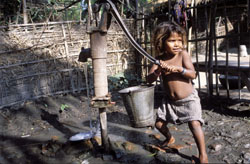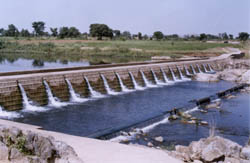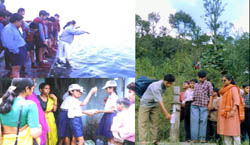|
Development
Alternatives and Water Management
O ver the past twenty years, Development Alternatives has designed and implemented numerous programmes and projects aimed at demonstrating better management of water resources. Many of them have been reported over the years in this Newsletter. This issue aims at highlighting, through random examples, some of this work to give a glimpse into the range and variety of alternatives that are needed to solve the problems of water scarcity.The need for a mix of approaches No problem that is complex can be solved with simple, one dimensional solutions. So, particularly, it is with water. Even so, it is useful to work on such issues through conceptual frameworks that are easily and widely understandable. The experience of Development Alternatives in the field of water boils down, as for many other spheres of our acitivity, to the three primary pillars of human endeavour:
The difference between how much rain and snow falls on the land surface of the subcontinent and how much water is available for productive use is largely a matter of how well our "natural" ecosystems are functioning. Before the massive destruction of forests, and precipitate fall of groundwater tables, these ecosystems produced more than sufficient fresh water to meet the needs of the people of India. Now, as a result of gross human interference, these ecosystems are no longer able to provide the natural reservoirs and buffers needed to maintain steady year round supplies of water. The result: a growing cycle of droughts and floods, each year increasing in intensity and human cost. Management of water resources The solutions lie in bringing back the trees and regenerating the acquifers. And these in turn need the same three pillars of human endeavour: good management practices to encourage the natural resource conservation, good science to desing such practices, and good institutions of governance to help internalise these practices into community decision making processes. Development Alternatives has more than fifteen years of successes in regenerating local water cycles by constructing water harvesting structures such as check dams, gully plugs and reservoirs. With some 100 check dams constructed in the rugged and dry area of Bundelkhand, we have been able to help local communities bring back to life several rivers and streams that had, over the past few decades, virtually died. Gradually, because of progressive deforestation and over-utilisation of water, their flows had deteriorated to the point that, for two or three months of the Monsoon, they were in flood and for the rest of the year they were quite dry. The solutions lie in a combination of traditional and high technology: land and water management techniques used for centuries by, for example, the Chandelas and Moghuls together with satellite imagery for site selection. Forestation, cropping and other land management practices reinforce the infiltration of water into the ground water acquifers, leading to year round flow of water in the streams. Several rivers have thus been rejuvenated through community action supported by various funding sources including government agencies at the national, state and local levels, private sector sponsors and foundations. Industry, agriculture and other water intensive activities must now be designed in the light of their impact on the hydrological cycle as much as on their economic and development implications. For this purpose, it becomes necessary to develop indicators of sustainable water use, for which some initial work has been done by Development Alternatives in the form of draft guidelines for panchayats and municipalities. Technologies for water The Swajal project being conducted by Development Alternatives in Jhansi District has shown us both how important it is to mobilise community participation in solving basic resource problems such as water, and how difficult it is to achieve this. The sense of dependency created over the past five decades by our systems of governance, have destroyed almost completely the desire and capacity of our fellow citizens to take responsibility for their resources, even when the outcome of doing so would mean a radical improvement in their living conditions. In this project several dozen villages have been working for several years, with varying degrees of success, to build simple water and sanitation systems for their villages. Water scarcity is not only a problem of quantity, but often also of quality. With more than a decade of work in this area, the Development Alternatives Group has tested several technologies for water purification. Among these, two have showed considerable potential for rural applications, solar stills and the "Portapak" water treatment device. Further tests are needed, however, before these technologies can be put on the market. Industrial water systems are equally important, and we have worked on projects for recycling, effluent treatment and for designing integrated clean technology systems with a wide range of industrial units. The CLEAN programme works with school children to monitor the quality of water sources in cities. Well trained monitors, equipped with the portable Jal-TARA water testing kit take responsibility for assessing water quality in selected parts of their city. The collect samples from piped water, ground water and surface water bodies and analyse the quality for 14 parameters. Now operating in some one dozen cities in different parts of India, CLEAN has mobilised child power not only to collect data, but also to analyse it and to campaign for technologies and policies that will result in better municipal water. The campaigns of CLEAN are also responsible for generating awareness to reduce the wasteful use of water. The CLEAN brigade in each city or town designs communications materials and exhibits to show how water resources can be better managed and works to convince the wider public of the need for responsibility on every ones part to conserve them. Institutions for water
As for other resource, the possibility of solving the water scarcity problem ultimately is one of management. And this relates to the whole issue of governance. The work of Development Alternatives reinforces the growing understanding among development practitioners that only when there is a sense of ownership among the local community over a resource can it be managed for the benefit of all and on a sustainable basis. Unfortunately, most policies relating to water have been somewhat shortsighted and narrowly conceived. Probably the most stark examples of such short-sighted policies and actions lie in the area of subsidies and pricing. In the management of water, as for many other resources, subsidies often lead to perverse results more or less the opposite of what they were intended to achieve. Introduction of subsidies is generally justified in terms of promoting equity, environmental improvement or use of better technology. But it is the rich who appropriate the benefits and it is the environment which suffers from excessive use of resources. Water for industrial, urban and agricultural use is grossly underpriced (often by a factor of 100 below either the cost of supplying it or the value addition it leads to).
Neither privatisation of such resources nor their delivery by government can maximise the direct benefits to the members of the community or minimise the indirect costs to the marginalised or to nature. A study of successful common property resource management systems quickly shows that properly designed community decision making systems are capable of distributing a resource such as water not only equitably but also efficiently. The work of Development Alternatives and People First points to solutions in which the government or the private sector should be responsible for "wholesale" (large scale, long distance) delivery, and the community (or "water cooperative") in the village and the neighbourhood in the town should be responsible for retail distribution. In any case, it has become clear that water can no longer be considered a free resource, both in that it costs money to deliver it and in that value is added by its use. When it is underpriced, it gets overused and if it is overpriced, it limits the value adding potential of other resources. Either way, it is sub-optimally used. Setting a price on water is, however, not a simple matter of neo-classical supply-demand economics: the marginal value of water and the capacity to buy it varies radically, not only from person to person but from time to time. Under these circumstances, neither the goals of efficiency nor of equity are served by the market. Nor are they served by mindless, simplistic, automatic reflex-based socialist ideas. Water must be priced, but needs to be priced differentially. The price of water has to be graded to ensure that this resource is available to all sections of society, not only on the basis of how much it costs and how much financial value it creates but also for the human and social impact it generates. Those, such as villagers or slum dwellers vulnerable to pathogens and illness, who need to use more of it should be encouraged to have greater access than their purchasing power now allows. On the other hand, the price of water for industries and rich farmers must be much higher than it is today to discourage awful, wasteful use they currently make of this precious resource. Recognising the importance of such issues and the need for greater clarity and consensus on them, Development Alternatives has been involved in a number of initiatives to put these issues onto the international and national agenda. q |
||||||||||||||||||||||||


